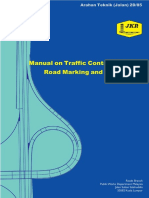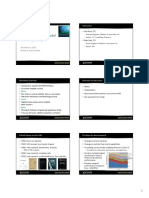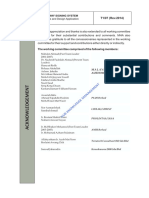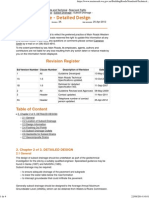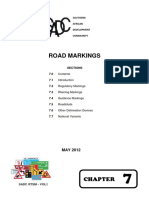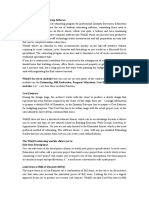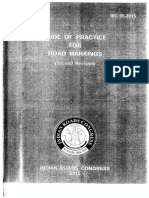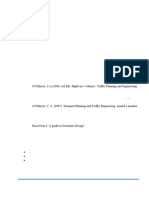Geometric Design of Roads
Geometric Design of Roads
Uploaded by
pakejulutCopyright:
Available Formats
Geometric Design of Roads
Geometric Design of Roads
Uploaded by
pakejulutOriginal Description:
Copyright
Available Formats
Share this document
Did you find this document useful?
Is this content inappropriate?
Copyright:
Available Formats
Geometric Design of Roads
Geometric Design of Roads
Uploaded by
pakejulutCopyright:
Available Formats
GEOMETRIC DESIGN OF ROADS GEOMETRIC DESIGN OF ROADS
TRAFFIC ENGINEERING
SAB3843
CHE ROS BIN ISMAIL
and
OTHMAN BIN CHE PUAN
SOME MAJOR ELEMENTS OF ROAD
GEOMETRY:
Horizontal alignment,
Vertical alignment,
Sight distances,
Cross-section, etc. Cross-section, etc.
Each element is designed in accordance
with various standard of practices such as
JKR, LLM, AASHTO, etc. to meet traffic flow
characteristics.
2
Why must we follow the standard
code of practice in the design?:
To ensure uniformity in the design,
To ensure smooth/consistent, safe and To ensure smooth/consistent, safe and
reliable traffic movements, and
To assist engineers in designing the
engineering details of the road sections
(less subjective decision).
3
Aspects considered in road design
Function to serve as inland linkage between locations for
moving people and goods.
Safety roadways must be designed with safety
characteristics.
Comfort road features must be designed and built for
comfort riding quality.
Economic in terms of construction and vehicles operating
costs.
Aesthetic roadways must be built as an element of the
environment; its design must include aethetical values to
suit the existing environment.
Road Classifications for Planning & Design
Purposes:
Four (4) Categories of Urban Roads:
1. Expressway divided highway for through traffic &
all junctions are grade separated.
2. Arterial major road, e.g., to carry traffic from
residential area to the vicinity of CBD. residential area to the vicinity of CBD.
3. Collector road to serve as a collector or
distributor of traffic between arterial and local road
systems.
4. Local street basic road network within a
neighborhood and serves primarily to offer direct
access to collectors.
Definition of R and U??
5
Road Classifications for Planning & Design
Purposes:
Five (5) Categories of Rural Roads:
1. Expressway divided highway for through traffic
& all junctions are grade separated.
2. Highway interstate national network & to serve 2. Highway interstate national network & to serve
long to intermediate trip lengths. It complements
the expressway network.
3. Primary road major road network within a state.
4. Secondary road major road network within a
district or regional development area.
5. Minor road local roads.
6
Design Standard Classifications:
R6/U6 highest geometric design standards; traveling
speed 90 km/h; divided highway with full access
control (F).
R5/U5 high geometric standards with speed 80
km/h; combination of divided & undivided sections;
partial access control (P). partial access control (P).
R4/U4 medium geometric standards with speed 70
km/h; usually with partial access control (P).
R3/U3 low geometric standard to serve local traffic;
partial (P) or no access control (N); speed 60 km/h.
R2/U2 low geometric standards for low volume of
local traffic; speed 50 km/h; no access control (N).
R1/U1 lowest geometric standards; speed 40 km/h
7
Flow Chart for Selection of Road Design Standards
Project Identification
Designate Road Group based on
nature of area road traverses
Select road category based on
function e.g. primary road
Select road category based
on function e.g. arterial
Rural Urban
Flow Chart for Selection of Road Design Standards
8
function e.g. primary road on function e.g. arterial
Estimate ADT at the end of design life
Determine design standard e.g. R6, U3 etc
Route location
Survey and Design
Selection of Design Standard
ADT
Area &
Road Category
All
traffic
volume
>10,000
3,000
to
10,000
1,000
to
3,000
150
to
1,000 < 150
RURAL:
Expressway R6 - - - - -
Selection of Design Standard
Expressway
Highway
Primary road
Secondary rd.
Minor road
R6
R5
-
-
-
-
-
R5
-
-
-
-
R4
R4
-
-
-
-
R3
-
-
-
-
-
R2
-
-
-
-
R1
URBAN:
Expressway
Arterials
Collector
Local street
U6
-
-
-
-
U5
U5
-
-
U4
U4
U4
-
-
U3
U3
-
-
-
U2
-
-
-
U1
9
Selection of Access Control
Design Standard
Area &
Road Category
R6/U6 R5/U5 R4/U4 R3/U3 R2/U2 R1/U1
RURAL:
Expressway F - - - - -
Selection of Access Control
Expressway
Highway
Primary road
Secondary rd.
Minor road
F
-
-
-
-
-
P
P
-
-
-
-
P
P
-
-
-
-
P
-
-
-
-
-
N
-
-
-
-
N
URBAN:
Expressway
Arterials
Collector
Local street
F
-
-
-
-
P
P
-
-
P
P
N
-
-
P
N
-
-
-
N
-
-
-
N
10
Criteria that govern the geometric
design
a) Terrain influences the design of both horizontal and
vertical alignments. Earthworks and construction costs
usually depend on the vertical alignment and terrain.
Operational characteristics, x section,
Road terrain is divided into 3 types, i.e: Road terrain is divided into 3 types, i.e:
(i) Level if the average slope of the contour is less
than 3%.
(ii) Rolling if slope in the range of 3 25%
(iii) Mountainous if slope greater than 25%.
b) Design Speed
Road
Hierarchy
Design Speed (km/h)
Terrain
Level Rolling Mountainous
R6 110 100 80 R6 110 100 80
R5 100 90 70
R4 90 80 60
R3 80 60 50
R2 60 50 40
R1 50 50 30
c) Design traffic volume & Ingress/Egress control
the ADT stated in Table may be taken as an
estimate of traffic at the end of the design life of the
road to build.
The ingress/egress control depends on the
requirements and its suitability with the type of the
road to build.
d) Design vehicle Weight, size, and operational d) Design vehicle Weight, size, and operational
characteristics of a vehicle determine the design of
the basic elements of a road section, i.e., radius of
road bends, pavement width, uphill and downhill
gradients, etc. Standards for design vehicle are
stipulated in REAM-GL 2/2002.
e) Capacity ideal condition, design volume, service
volume, and LOS and v/c
Design of the highway elements
Sight distances
Alignments
Sight Distances
Sight distance is the forward distance measure from
vehicle within which all objects are visible by the
driver while driving. The distance is influenced by
factors such as:
Drivers perception & reaction time,
Deceleration & acceleration rates,
Friction between tyre and road surface,
Height of the drivers eyes & objects on the
road, etc.
Braking or Stopping Sight Distance
Consists of two components:
(a) Distance travelled during perception time (d
1
):
d
1
= 0.28Vt meter
with V = vehicles speed (km/h)
t = perceptionreaction time (sec)
(b) Distance travelled during braking (d
2
):
( ) G f
U V
d
+
=
254
2 2
2
meter.
V = initial speed (km/h)
U = final speed (km/h) = 0 if vehicle stops
G = gradient of the road
f = side friction between road surface and tyre
Stopping Sight Distance = 0.28Vt + (V
2
U
2
)/254(f + G) meter
ZON HAD LAJU
Some examples of the application of sight
distance design
to ensure that safety elements are included in the
geometry design
to determine the locations of warning/reminder system
to the drivers/users
SIMPANG
300 METER
DI HADAPAN
ZON HAD LAJU
500 METER
DI HADAPAN
70
EXAMPLE 1
A driver takes 3.2 s to react to a complex situation
while traveling at a speed of 55 km/h. How far does
the vehicle travel before the driver initiates a physical
response to the situation (i.e., putting his or her foot
on the brake) ?. on the brake) ?.
EXAMPLE 2
What is the safe stopping distance for a section of
rural freeway with a design speed of 80 km/h on a
4% uphill grade ?. Use perception-reaction time of
2.5 s and coefficient of friction of 0.25.
EXAMPLE 3
Drivers must slow down from 110 km/h to 70 km/h
to negotiate a severe curve on a rural highway. A
warning sign for the curve is clearly visible for a
distance of 50 m. How far in advance of the curves
must the sign be located in order to ensure that must the sign be located in order to ensure that
vehicles have sufficient distance to safely decelerate?
Use the perception-reaction time of 1.5 s and
coefficient of friction of 0.30.
Passing or Overtaking Sight Distance
Overtaking
vehicle
Overtaken
vehicle
Oncoming vehicle in the
opposite lane
d
1
d
2
d
3
d
4
D = d
1
+ d
2
+ d
3
+ d
4
D
Minimum Passing Sight Distances
Design Speed (km/h) Minimum Passing Sight
Distance (m)
110
100
90
730
670
610
Minimum Passing Sight Distances
80
70
60
50
40
30
550
490
410
350
290
230
22
Criteria for measuring sight distance?
REAM pg 31
Horizontal & vertical alignments concern with the
design of the turning radius and road gradients. To meet
the safety requirements, road physical design is
balanced with the characteristics that influence drivers
such as sight distance.
Design of the highway Elements
such as sight distance.
Horizontal Alignment
It concerns with the design of the road section as it
is seen from birds eye view a straight section or a
road bend.
If a road bend is required, what is shape and what is If a road bend is required, what is shape and what is
the radius of the bend?
Base on a simple circular curve
Base on a spiral curve (i.e. a combination of a
circular curve and transition curves)
Minimum Radius of Circular Curve
V
2
R =
_________________
meter
127 (e + f)
V = design speed in km/h
e = superelevation
f = road surface friction
R 48 . 30 2
=
30.48 m
R R
D
o
Length of the curve, L
Degree of curvature, D
Degree of Curvature
R
D
D
2
) 360 ( 48 . 30
360
=
=
360
2
48 . 30
48 . 30
=
=
R L
or
D
L
D
L
Length of the long chord, L.C.
( )
2
sin 2 . .
R C L =
Length of the tangent, T
( )
2
tan
R T =
Length of the external distance, E
( )
4
tan
T E =
Length of the middle ordinate, M
( )
2
cos
E M =
Once the length of the tangent and the length of the curve
are known, the stations for the PC and PT can be determined:
L C P T P
T I P C P
+ =
=
. . . .
. . . .
L C P T P + = . . . .
EXAMPLE 4
The point of intersection (P.I.) of two tangent lines is
station 15+20. The radius of curvature is 275 m, and
the angle of deflection is 52
o
. Find the length of the
curve, the station for the P.C. and P.T., and all other
relevant characteristics of the curve (L.C., M, E). relevant characteristics of the curve (L.C., M, E).
O
R
D
D
R
35 . 6
) 275 ( 2
) 360 ( 48 . 30
2
) 360 ( 48 . 30
48 . 30
360
2
= = =
=
SOLUTION
30.48m
R R
D
o
SOLUTION
R ) 275 ( 2 2
Length of the curve
m
D
L
D
L
O
O
64 . 249
35 . 6
52
48 . 30 48 . 30
48 . 30
=
=
=
SOLUTION
Length of the long chord
( ) ( ) m R C L 10 . 241
2
52
sin 275 2
2
sin 2 . . = = =
Length of the tangent
( ) ( ) m R T 13 . 134
2
52
tan 275
2
tan = = =
( ) ( ) m R T 13 . 134
2
tan 275
2
tan = = =
Length of the external distance
( ) ( ) m T E 97 . 30
4
52
tan 13 . 134
4
tan = = =
Length of the middle ordinate
( ) ( ) m E M 84 . 27
2
52
cos 97 . 30
2
cos = = =
SOLUTION
Once the length of the tangent and the length of the curve
are known, the stations for the PC and PT can be determined:
sta L C P T P
sta T I P C P
51 . 35 16 51 . 1635 64 . 249 87 . 1385 . . . .
87 . 85 13 87 . 1385 13 . 134 1520 . . . .
+ = = + = + =
+ = = = =
sta L C P T P 51 . 35 16 51 . 1635 64 . 249 87 . 1385 . . . . + = = + = + =
EXAMPLE 5
Two tangent lines meet at Station 320+15. The radius
of curvature is 360m, and the angle of deflection is
14
o
. Find the length of the curve, the station for the
P.C. and P.T., and all other relevant characteristics of
the curve (L.C., M, E). the curve (L.C., M, E).
O
R
D
D
R
85 . 4
) 360 ( 2
) 360 ( 48 . 30
2
) 360 ( 48 . 30
48 . 30
360
2
= = =
=
SOLUTION
30.48 m
R R
D
o
SOLUTION
R ) 360 ( 2 2
Length of the curve
m
D
L
D
L
O
O
94 . 87
85 . 4
14
48 . 30 48 . 30
48 . 30
=
=
=
SOLUTION
Length of the long chord
( ) ( ) m R C L 75 . 87
2
14
sin 360 2
2
sin 2 . . = = =
Length of the tangent
( ) ( ) m R T 20 . 44
2
14
tan 360
2
tan = = =
( ) ( ) m R T 20 . 44
2
tan 360
2
tan = = =
Length of the external distance
( ) ( ) m T E 70 . 2
4
14
tan 20 . 44
4
tan = = =
Length of the middle ordinate
( ) ( ) m E M 68 . 2
2
14
cos 70 . 2
2
cos = = =
SOLUTION
Once the length of the tangent and the length of the curve
are known, the stations for the PC and PT can be determined:
sta T I P C P 8 . 70 319 8 . 31970 20 . 44 32015 . . . .
+ = = + = + =
+ = = = =
sta L C P T P 74 . 58 320 74 . 32058 94 . 87 8 . 31970 . . . . + = = + = + =
Transition or Spiral Curve
When vehicles enter or leave a circular
horizontal curve, the gain or loss of centrifugal
force cannot be effected instantaneously,
considering safety and comfort.
In such cases, the insertion of transition curves
between tangents and circular curves warrants
consideration.
A properly designed transition curve
provides the following advantages
A natural, easy to follow path for drivers such that the
centrifugal force increases and decreases gradually
as a vehicle enters and leaves a circular curve
A convenient desirable arrangement for A convenient desirable arrangement for
superelevation runoff
Flexibility in the widening of sharp curves
Enhancement in the appearance of the highway.
A basic formula used for computing
the minimum length of a spiral is
3
2
1
p
R g e
v
v
L metre
c R
Where:
Lp =minimum length of spiral (metre)
V = design speed (metre/sec)
R = radius of the circular curve (metre)
g = acceleration due to gravity = 9.81 m/s
2
e = superelevation (percent per hundred)
c = rate of increase of centrifugal acceleration
(between 0.30 and 0.91 m/s
3
)
c R
Example (P 6)
A curve has been designed using combination of
circular and spiral curve for 90km/hr and:
Deflection angle = 15 30
Side friction = 0.12
Superelevation = 6% Superelevation = 6%
Radial acceleration = 0.9m/s
3
Determine the minimum radius, length of transition
curve, and total length of the curve
Superelevation table, methods of attaining
superelevation, widening
Vertical Alignment
Concerns with the design of the longitudinal
crosssection of a roadway
Vertical curves are in the shape of a parabola.
Types of vertical curves:
Uphill or downhill slopes
Crest vertical curves the entry tangent grade
is greater than the exit tangent grade.
Sag vertical curves - the entry tangent grade is
lower than the exit tangent grade.
Uphill and Downhill Slopes
Gradient or slope must be selected in such a
way that the performance of vehicles are not
affected especially the uphill gradient.
Two aspects considered are:
Maximum Gradient
Length of Critical Gradient
42
Level road, G = 0%
Design speed
(km/h)
Desired maximum
gradient (%)
Acceptable maximum
gradient (%)
120 2 5
100 3 6
Refer REAM pg 45-46
80 4 7
60 5 8
50 6 9
40 7 10
30 8 12
20 9 15
43
Refer REAM pg 46-47
Design speed (km/h) Gradient (%)
Length of the critical
gradient (m)
120 3
4
5
500
400
300
100 4
5
6
500
400
300
80 5
6
7
500
400
300
60
6
7
8
300
250
200
44
EXAMPLE 7
A vertical curve of 300m is designed to connect
a grade of +4% to a grade of -5%. The V.P.I. is
located at station 15+55 and has a known
elevation of 150m. Find the following:
(a) the station of the V.P.C. and the V.P.T.
(b) the elevation of the V.P.C. and the V.P.T.
(c) the location and elevation of the high point
on the curve.
SOLUTION
(a) Stations for the V.P.C. and the V.P.T.
Length along a vertical curve is measured in the plan view.
Thus for a curve of 300m, the V.P.I. is located at the
midway point i.e. 150m away from the V.P.C. and the V.P.T.
Thus the stations for these points are:
V.P.C.= (15+55) 150 = 14+05 m
V.P.T. = (15+55) + 150 = 17+05 m
SOLUTION
(b) i. Elevation of the V.P.C.
The grade between the V.P.C. and V.P.I. is +4%. The
V.P.C., therefore has an elevation of:
Y
VPC
= Y
o
= 0.04(-150) + 150 = 144 m
(b) ii. Elevation of the V.P.T.
The elevation of the V.P.T. is at the end of the vertical
curve, at a distance of 300 m (L=3) from the V.P.C.
Therefore:
m Y x G
rx
Y
o VPT
5 . 142 144 ) 3 ( 4 3
3 2
4 5
2
2
1
2
= + +
= + + =
SOLUTION
(c) High point of the curve and the elevation
The high point on the curve is located at the point where
the first derivative of the curve is zero. This occurs when
x is:
33 . 1
4 5
) 3 ( 4
1 2
1
=
=
G G
L G
x
Then, the elevation of the high point is found by using the
curve equation:
m Y x G
rx
Y
o X
67 . 146 144 ) 33 . 1 ( 4 33 . 1
3 2
4 5
2
2
1
2
= + +
= + + =
EXAMPLE 8
A -2.5% grade is connected to a +1.0% grade by
means of a 180m vertical curve. The P.I. station is
121+21 and the P.I. elevation is 88.888m above sea
level. What are the station and elevation of the
lowest point on the vertical curve? lowest point on the vertical curve?
SOLUTION
Rate of change of grade:
( )
sta
sta L
G G
r / % 944 . 1
80 . 1
% 5 . 2 % 0 . 1
1 2
=
=
=
Station of the low point:
0 int, =
dx
dY
po low At
X
60 121 ) 29 1 ( ) 31 120 ( int
31 120 ) 90 0 ( ) 21 121 ( :
29 1 29 . 1
944 . 1
5 . 2
0
1
1
+ = + + + =
+ = + +
+ = =
=
+ = =
po low of Station
BVC of Station
sta
r
G
x
or
G rx
dx
dY
dx
X
SOLUTION
Elevation of BVC:
m sta m Y
o
138 . 91 %) 5 . 2 )( 9 . 0 ( 888 . 88 = + =
Elevation of low point:
o X
Y x G
rx
Y + + =
1
2
22
m sta
sta sta
138 . 91 ) 29 . 1 %)( 5 . 2 (
2
) 29 . 1 )( / % 944 . 1 (
2
+ + =
m 531 . 89 =
Other Considerations
REAM GL-2/2002
1. Maximum grades T 4-9x
2. Minimum grades
3. Critical grade length F 4-5
4. Climbing lanes for two-lane roads 4. Climbing lanes for two-lane roads
5. Passing lane section in two-lane roads
6. Climbing lane on multilane roads
7. Combination of vertical and horizontal curve
Typical Elements of Highway Cross-section
shoulder
reserve
Right-of-Way
Traffic
lane
Traffic
lane
reserve
shoulder
(a) single-carriageway road
Road
Median
(b) dual-carriageway road
Traffic
lane
Traffic
lane
Right-of-Way
reserve reserve
shoulder shoulder
Problem Solving (PO4)
Horizontal curve R = 250m of two lane highway with
speed limit of 60 km/h, the curve is not super-
elevated. Determine the horizontal sight line offset
(HSO) where a billboard can be placed from the
centerline of the inside lane of the curve, without centerline of the inside lane of the curve, without
reducing the required SSD. PIEV = 2.5s and f = 0.35
REFERENCES
1. Othman Che Puan. Modul Kuliah Kejuruteraan Lalu Lintas. Published for
Internal Circulation, 2004.
2. Dorina Astana, Othman Che Puan, Che Ros Ismail, TRAFFIC ENGINEERING
NOTES, Published for Internal Circulation, 2011.
3. Garber, N.J., Hoel, L.A., TRAFFIC AND HIGHWAY ENGINEERING,4
th
Edition,
SI Version., Cengage Learning, 2010.
4. Road Engineering Association of Malaysia, A GUIDE ON GEOMETRIC 4. Road Engineering Association of Malaysia, A GUIDE ON GEOMETRIC
DESIGN OF ROADS, REAM-GL 2/2002, 2002.
5. Oglesby, C.H., Hicks, R.G., HIGHWAY ENGINEERING, John Wiley & Sons,
1982.
You might also like
- Assignment Chapter 6 - Hydrology ModellingDocument10 pagesAssignment Chapter 6 - Hydrology ModellingMohd Hafiez HamidNo ratings yet
- Basic Highway Design ChecklistDocument13 pagesBasic Highway Design ChecklistSyed Ali Raza ShahNo ratings yet
- 1 PDFDocument32 pages1 PDFdraipl iplNo ratings yet
- The City of Tshwane Roads and Stormwater Division: 15 September 2008Document5 pagesThe City of Tshwane Roads and Stormwater Division: 15 September 2008MichaelNo ratings yet
- Item Description Unit Qty Rate Amount (RM) : Page BQ1 1/1Document31 pagesItem Description Unit Qty Rate Amount (RM) : Page BQ1 1/1vani2620No ratings yet
- Paper 1 - Overview of Geometric Design of Roads 2013aDocument38 pagesPaper 1 - Overview of Geometric Design of Roads 2013aObinna ObiefuleNo ratings yet
- Guide At-Grade IntersectionsDocument83 pagesGuide At-Grade IntersectionsZairi bin Zaini100% (3)
- 4-Abu Dhabi Urban Street Design Manual USDMDocument26 pages4-Abu Dhabi Urban Street Design Manual USDM316817013No ratings yet
- Manual On Traffic Control Devices: Road Marking and DileanationDocument39 pagesManual On Traffic Control Devices: Road Marking and DileanationSam KhorNo ratings yet
- IntersectionsDocument42 pagesIntersectionsJerosalem ParaanNo ratings yet
- Calming Design GuidelineDocument25 pagesCalming Design GuidelineAnorld WalkerNo ratings yet
- Analysis and Execution of Road WorkDocument86 pagesAnalysis and Execution of Road WorkRahul Jha67% (3)
- JKR Manual On Traffic ControlDocument90 pagesJKR Manual On Traffic Controlyuziebm100% (6)
- A Guide To The Design of at Grade Intersections PDFDocument84 pagesA Guide To The Design of at Grade Intersections PDFLuis Artiaga Ben100% (3)
- 3 Key Steps in A Road Safety InspectionDocument37 pages3 Key Steps in A Road Safety Inspectiondario_791473996No ratings yet
- Site Clearance and Earthwork CHP 3Document20 pagesSite Clearance and Earthwork CHP 3dhevashini narayananNo ratings yet
- Road Cross SectionDocument61 pagesRoad Cross SectionAnonymous 4ghB3BQ100% (1)
- Roundabout Design ParametersDocument7 pagesRoundabout Design Parametersavhnmurthy100% (1)
- Roadside Features DesignDocument60 pagesRoadside Features Designadeolaodukoya100% (1)
- Geometric Design ManualDocument240 pagesGeometric Design ManualRiyaad MandisaNo ratings yet
- On Our Way-Accessibility Checklist enDocument31 pagesOn Our Way-Accessibility Checklist enVaishnavi JayakumarNo ratings yet
- Three Residential Subdivisions in The Western Neighbourhood (Area 1) Lancefield TownshipDocument36 pagesThree Residential Subdivisions in The Western Neighbourhood (Area 1) Lancefield Townshippea yangNo ratings yet
- Hump CircularDocument10 pagesHump Circularsuresh babu ckNo ratings yet
- HCM 6 Edition: A Guide For Multimodal Mobility Analysis: InstructorsDocument43 pagesHCM 6 Edition: A Guide For Multimodal Mobility Analysis: InstructorsMohammed Jahanzeb ChoudaryNo ratings yet
- Sports Field DrainageDocument3 pagesSports Field DrainagePeter Jean-jacquesNo ratings yet
- What Is A Standard Operating Procedure?Document1 pageWhat Is A Standard Operating Procedure?AshishNo ratings yet
- T1-07Rev.2014 13 Jan 2016 PDFDocument58 pagesT1-07Rev.2014 13 Jan 2016 PDFMohd Aizat DasimNo ratings yet
- Road Sign - EAL 338-NewDocument35 pagesRoad Sign - EAL 338-NewNasrulNo ratings yet
- Design Flexible ATJ 5I85 2013 2022Document33 pagesDesign Flexible ATJ 5I85 2013 2022Leediya AfrinaNo ratings yet
- Guide On Geometric Design of RoadDocument113 pagesGuide On Geometric Design of RoadKha Mn100% (2)
- Chapter 3 - 9 (20212022-II) - ATJ 13-87pindaan2017 - 2edHODocument18 pagesChapter 3 - 9 (20212022-II) - ATJ 13-87pindaan2017 - 2edHONor Azwin BahariNo ratings yet
- Chapter 7 - Traffic Signs, Markings and SignalsDocument64 pagesChapter 7 - Traffic Signs, Markings and SignalsLewisMunene0% (1)
- Route Location Data Collection: Road Design Check ListDocument2 pagesRoute Location Data Collection: Road Design Check Listzeroicesnow100% (1)
- Road ConstructionDocument53 pagesRoad ConstructionTinio Joseph100% (1)
- Chapter 8A Junction DesignDocument38 pagesChapter 8A Junction DesignAmir AlistyNo ratings yet
- Department of Road 2010-13Document32 pagesDepartment of Road 2010-13Ramesh PokharelNo ratings yet
- Subsoil Drainage Detailed DesignDocument4 pagesSubsoil Drainage Detailed Designbirajr78No ratings yet
- Road Reclassification and Road Numbering System Report (2016 - 02 - 12 08 - 14 - 22 UTC) PDFDocument42 pagesRoad Reclassification and Road Numbering System Report (2016 - 02 - 12 08 - 14 - 22 UTC) PDFAngela LopezNo ratings yet
- MeasurIT Tideflex Valves Full 0912Document9 pagesMeasurIT Tideflex Valves Full 0912Lalo SepulvedaNo ratings yet
- Chapter 3 Pavement Patching and RepairDocument28 pagesChapter 3 Pavement Patching and RepairCollin Legaspina100% (2)
- Evaluation of Traffic Signal CoordinationDocument11 pagesEvaluation of Traffic Signal Coordinationnokibe4356100% (1)
- Description Qnty. Unit Rate Total: Preliminaries Protection and SecurityDocument7 pagesDescription Qnty. Unit Rate Total: Preliminaries Protection and Securitytribsa67No ratings yet
- 12 DMRBDocument68 pages12 DMRBSyed Ali Raza Shah100% (1)
- 3.1 - Cross Section Elements FDocument66 pages3.1 - Cross Section Elements FKirtiyadavNo ratings yet
- Chapter-2 Traffic SignsDocument26 pagesChapter-2 Traffic SignsHarshitha RaviNo ratings yet
- Slope ProtectionDocument3 pagesSlope Protectionshima2727No ratings yet
- Road Traffic Signs Manual Vol 1 Chapter 7 PDFDocument81 pagesRoad Traffic Signs Manual Vol 1 Chapter 7 PDFLima PalaveNo ratings yet
- Marking Road BookDocument91 pagesMarking Road BookShahzad DurraniNo ratings yet
- 1718 QTS 517 - WinQSDocument4 pages1718 QTS 517 - WinQSAyomide AdediranNo ratings yet
- UTG 1 Guidelines For The Geometric Design of Urban Arterial RoadsDocument76 pagesUTG 1 Guidelines For The Geometric Design of Urban Arterial Roadspelika_sueNo ratings yet
- Highway Engineering TRAN 3001 Lecture 10Document33 pagesHighway Engineering TRAN 3001 Lecture 10Donothan SookrajNo ratings yet
- IRC - 035 - 2015 Road Markings-SearchableDocument155 pagesIRC - 035 - 2015 Road Markings-SearchableChandra SekharNo ratings yet
- CHAPTER 3.0 - 12jan.2012 - 3.33pmDocument105 pagesCHAPTER 3.0 - 12jan.2012 - 3.33pmAlaziz AzzizzNo ratings yet
- Chapter 4.0 Geometric Design of Highway and Streets - Sept2016Document256 pagesChapter 4.0 Geometric Design of Highway and Streets - Sept2016dzikryds50% (2)
- Highway Alignment PrinciplesDocument89 pagesHighway Alignment PrinciplesAram Avetisyan60% (5)
- Chapter 3Document41 pagesChapter 3Muhammad Farhan GulNo ratings yet
- Horizontal Curves-Superelevation-And Geometric Design StandardsDocument41 pagesHorizontal Curves-Superelevation-And Geometric Design Standardsmannie edet100% (1)
- (1 Marks) (2 Marks)Document4 pages(1 Marks) (2 Marks)clara slumpaNo ratings yet
- CSEN 412-Chapter 1-Traffic Flow and Capacity DesignDocument20 pagesCSEN 412-Chapter 1-Traffic Flow and Capacity DesignkashelrukiaNo ratings yet
- Session 2a - Horizontal Curves-Superelevation-And Geometric Design StandardsDocument43 pagesSession 2a - Horizontal Curves-Superelevation-And Geometric Design Standardsmannie edetNo ratings yet








